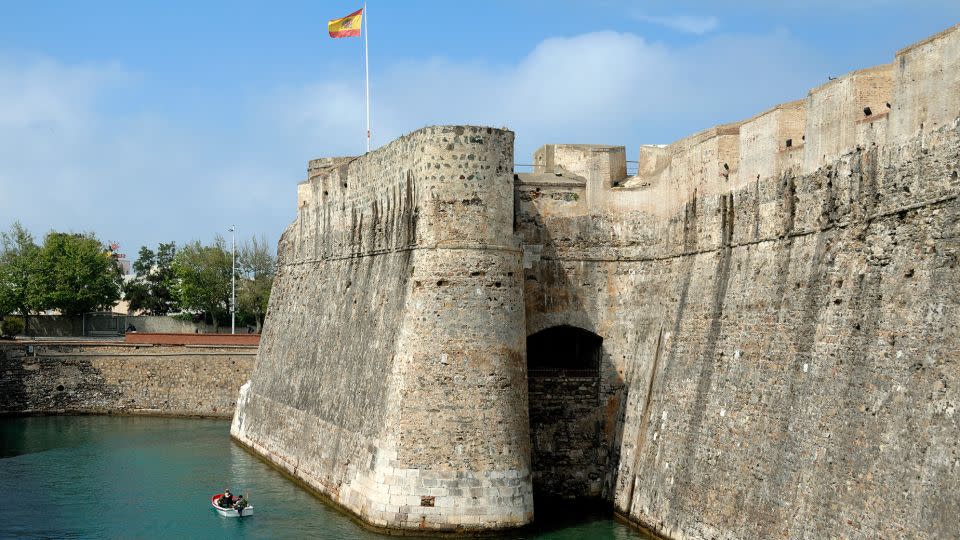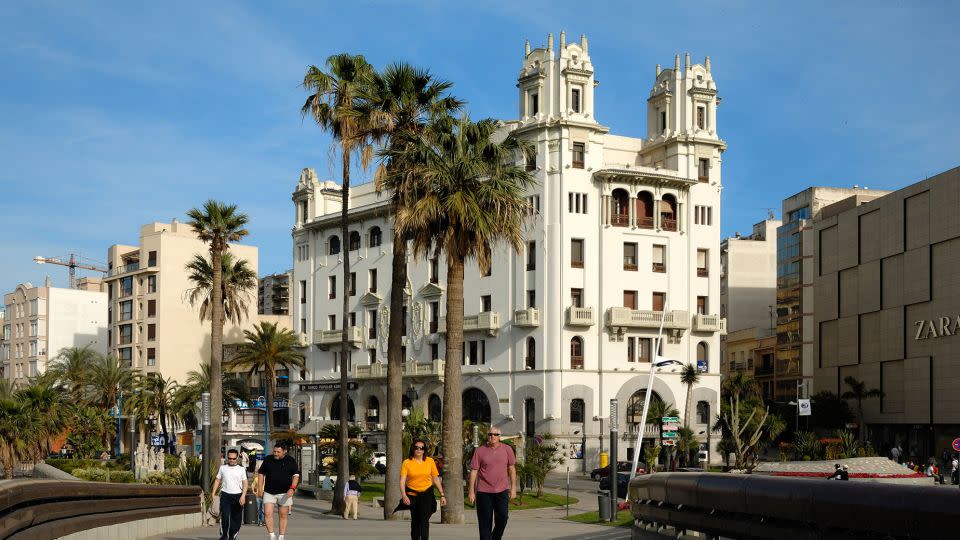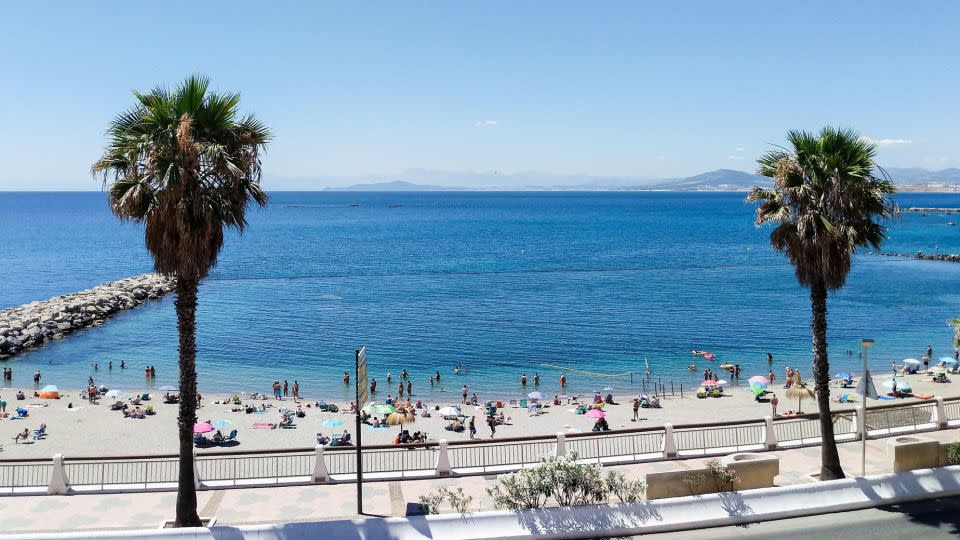In ancient Greek and Roman legend, the Pillars of Hercules – which marked the edge of the known world – were mighty pillars that once stood on either side of the strait where the Mediterranean meets the Atlantic.
One was on the Rock of Gibraltar, a piece of British territory adjacent to mainland Spain, and the other was Ceuta, a prominent rocky outcrop on the North African coast.
Today Ceuta is a Spanish exclave, a part of a country completely surrounded by another, in this case Morocco. And although this tiny part of Europe in Africa is only 29 kilometers from mainland Spain, it is one of the most unusual places on both continents.
Surrounded by water on three sides, Ceuta is protected by high medieval walls, stone citadels and barbed wire, all of which hint at its turbulent history.
With an area of just seven square miles and a population of around 85,000 people, this peninsula jutting steeply into the Mediterranean has been owned by Spain since 1580.
But the exclave is more than just a colonial remnant; With architecture, culture and cuisine combining influences from both sides of the Strait of Gibraltar, this could be the most multicultural city in Spain.
“Ceuta has been awarded the title of the most loyal city in Spain,” Mila Bernal, a representative of the local tourism office, told CNN Travel. “Because the citizens decided they wanted to be Spanish and not Portuguese.”
Gateway to Africa

Ceuta’s history is complicated. Standing on the 16th-century royal walls that still surround the exclave’s old town, Bernal explained how the Portuguese captured Ceuta in 1415 as the Christian Reconquista of the Iberian Peninsula pushed across the Mediterranean and into the Moorish heartland.
Portugal and Spain were united under a single monarch in 1580, and so Ceuta fell under the rule of the Iberian Union until 1640, when Portugal seceded.
However, the inhabitants of Ceuta, most of whom had emigrated from Spanish rather than Portuguese territories in mainland Europe, decided they preferred to side with Spain.
Prized for its strategic location, the city dates back to ancient times, and due to its prominence guarding the Strait of Gibraltar, every major Mediterranean power has either claimed or conquered Ceuta.
Next to Ceuta Cathedral are Phoenician ruins from the 7th century BC. The Mediterranean sailors founded a small settlement here as part of their growing maritime empire. Later came the Carthaginians and Romans, who had to secure the gate to Africa.
“The Romans believed that Mount Hacho was the Pillar of Hercules. “It was the end of the world for the Romans,” Bernal said, pointing to the high peak that overlooks the exclave. “They named the city Septum after its seven hills, from which the modern name ‘Ceuta’ evolved.”
Fierce battles
A monumental bronze statue depicting Hercules pushing aside the great columns greets disembarking passengers on the Mediterranean coast of Ceuta today.
After the fall of the Roman Empire, the Byzantines took over Ceuta and there were fierce battles with Vandals and Visigoths for control of the area.
In the 8th century, the Islamic Umayyad dynasty conquered North Africa, conquering everything in its path, including Ceuta. Arab, Moorish and Berber kingdoms took control of the city until the Portuguese and Spanish arrived in the 15th century and asserted a European claim that has endured for 400 years.
The easiest way to get to Ceuta from Europe is by ferry from Algeciras, a port city on mainland Spain, across the dolphin-rich waters of the Strait of Gibraltar.
Many Spaniards make the trip as a holiday trip, and the trip is certainly not without tourist attractions.
Rival claims


As you explore the area’s tapas bars and Catholic cathedrals, visitors will encounter lasting reminders of past rulers: the Roman Basilica Museum – which contains some of the oldest Christian relics ever discovered in North Africa – as well as the Arab Baths and the Moorish Architecture You won’t be out of place in the southern Spanish cities of Granada, Cordoba or Morocco’s port of Tangier.
There are hikes to epic viewpoints like the Mirador de San Antonio, which offer panoramic views of Ceuta, Morocco and the Strait of Gibraltar. And there are beaches for relaxing and sunbathing.
Then in Benzú, on the territory’s northern coast, there is the opportunity to sip Moroccan tea in the shade of a mosque, hike to ancient fortresses and modern watchtowers on the border, and continue to visit the hectic Moroccan city of Tétouan.
Ceuta has been fought over for thousands of years and is officially considered an autonomous Spanish city. It also belongs to the European Union and is one of two Spanish exclaves on the North African Mediterranean coast. The other is Melilla, a city also of around 85,000 people, about 250 miles east of Ceuta, which also borders Morocco.
As might be expected, Morocco disputes Spain’s sovereignty over these two exclaves, citing geographical and historical links with the territories dating back to the Islamic conquests.
In the 18th century, the Sultan of Morocco failed to take Ceuta after a 30-year siege. Another siege in the early 19th century also failed.
In the centuries that followed, border disputes led to intermittent wars and battles until much of Morocco was colonized by Spain and France in the 19th and 20th centuries.
While Morocco gained independence in 1956, Spain retained Ceuta and Melilla.
It is a dispute that is still deeply rooted, and in 2023 Spain’s Prime Minister Pedro Sánchez complained to Moroccan authorities when Moroccan maps included both Ceuta and Melilla within the country’s borders. The year before, Spanish media reported that Sanchez declared that “Ceuta and Melilla are Spain, period,” after Morocco complained to the United Nations that “Melilla is a Spanish-occupied prison.”
There is endless talk, but all too often the dialogue on the ground in Ceuta comes to a head.
Cultural mix


While the city, as an outpost of the EU in Africa, no longer marks the edge of the known world as it did for the Romans, Ceuta is considered a gateway to Europe for many migrants looking for a better life. Therefore, the territory’s land border with Morocco is surrounded by watchtowers and barbed wire, which can be seen from the beach when boarding a bus from the city to the town of Benzú.
Morocco often uses Ceuta as a political bargaining tool, threatening to open its side of the border and allow large numbers of African migrants to attempt to enter the EU. Morocco remains steadfast in its claim to Ceuta, but for the Spaniards living in the exclave it is an integral part of Spain.
“Morocco always wants Ceuta,” Bernal said, before offering one of Spain’s long-standing arguments for Spanish sovereignty. “But it was never Moroccan, Morocco never existed until the 19th century, so how can they reclaim what was never theirs?”
Although Ceuta is part of modern Spain, Ceuta’s curious identity reflects its North African location. At Playa de la Ribera, where Spanish holidaymakers enjoy the sun, the Muslim call to prayer can be heard and minarets can be seen on the skyline.
Every day thousands of Moroccans cross the border to work in Ceuta, and both Arabic and Spanish are spoken on the streets. Churches stand next to mosques, Sephardic synagogues and even Hindu temples. As of 2022, Ceuta declared that Muslim holidays such as Eid al Fitr were public holidays, on an equal footing with Christian celebrations in the exclave.
Geographically, Ceuta is in North Africa, politically it is Spanish, but culturally, elements of both continents and worlds – Muslims and Christians – coexist.
For more CNN news and newsletters, create an account at CNN.com
